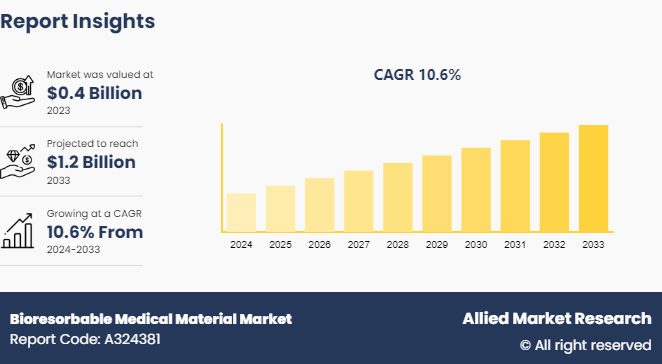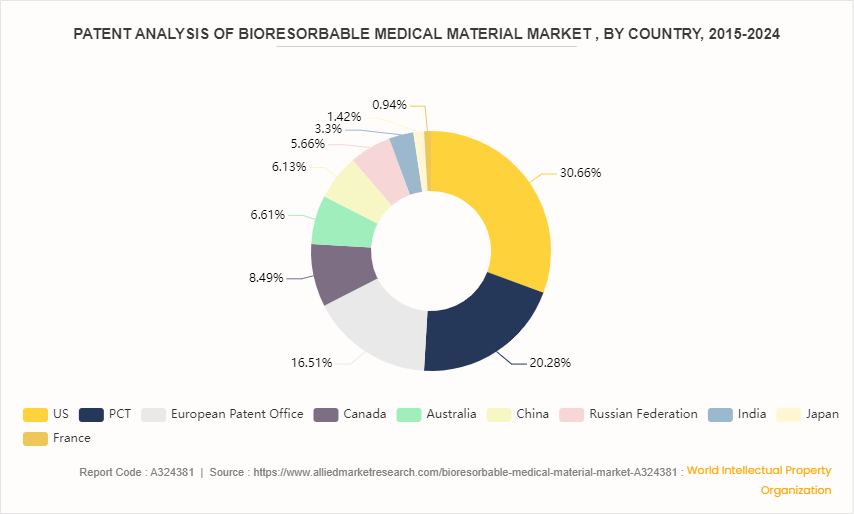Bioresorbable Medical Material Market Research, 2033
The global bioresorbable medical material market size was valued at $0.4 billion in 2023, and is projected to reach $1.2 billion by 2033, growing at a CAGR of 10.6% from 2024 to 2033. The bioresorbable medical material market is driven by the increasing demand for minimally invasive surgeries and advancements in material science. Additionally, the rising prevalence of chronic diseases and the need for effective, temporary implants contribute to market growth.

Market Introduction and Definition
Bioresorbable medical materials are specialized substances designed to be absorbed or dissolved by the body over time after fulfilling their intended function. These materials are used in various medical applications, such as implants, surgical devices, and drug delivery systems, to support healing and recovery while minimizing the need for additional surgeries to remove them. Unlike traditional materials, which remain in the body indefinitely, bioresorbable materials gradually degrade into non-toxic byproducts that are safely absorbed and eliminated by the body's natural processes.
This characteristic makes them particularly valuable in applications like bone repair, sutures, and stents, where temporary support is needed until natural healing occurs. The development of bioresorbable materials involves advanced polymer science and biocompatibility studies to ensure they perform effectively and safely within the physiological environment.
Key Takeaways
- The Bioresorbable medical material market study covers 20 countries. The research includes a segment analysis of each country in terms of value ($Million) for the projected period 2023-2033.
- More than 1, 500 product literatures, industry releases, annual reports, and other such documents of major bioresorbable medical material industry participants along with authentic industry journals, trade associations' releases, and government websites have been reviewed for generating high-value industry insights.
- The study integrated high-quality data, professional opinions and analysis, and critical independent perspectives. The research approach is intended to provide a balanced view of global markets and to assist stakeholders in making educated decisions in order to achieve their most ambitious growth objectives.
Key Market Dynamics
The growth of the bioresorbable medical material market size is primarily driven by advancements in material science and increasing demand for minimally invasive medical solutions. Innovations in polymer chemistry have led to the development of new bioresorbable materials, such as polylactic acid (PLA) and polycaprolactone (PCL) , which offer enhanced biocompatibility and controlled degradation rates.
The rise in orthopedic surgeries and trauma cases is another significant driver, as bioresorbable implants, like screws and plates, eliminate the need for second surgeries to remove hardware. Additionally, the expanding use of bioresorbable stents in cardiology reflects the push towards reducing long-term complications and improving patient outcomes. Regulatory approvals for new bioresorbable products further propel market growth by increasing their availability and application across various medical fields.
Despite their advantages, bioresorbable medical materials face several challenges during bioresorbable medical material market forecast. One major restraint is the relatively high cost associated with the development and production of these advanced materials. For example, bioresorbable stents and orthopedic devices are often more expensive than their traditional counterparts, which can limit their adoption in cost-sensitive markets.
Additionally, there are concerns about the long-term performance and reliability of these materials, especially in high-stress applications. The degradation rate of bioresorbable materials must be precisely controlled to ensure they provide adequate support while minimizing potential adverse effects. Regulatory hurdles and the need for extensive clinical trials also pose significant barriers, slowing down the introduction of new products to the market.
Moreover, the market presents several exciting opportunities for bioresorbable medical material market growth. Advances in 3D printing technology are enabling the customization of implants and devices, allowing for more personalized medical solutions that better fit individual patient needs. This is particularly promising in orthopedic applications, where custom bioresorbable implants can enhance healing and recovery.
Furthermore, there is significant potential in expanding the use of bioresorbable materials in drug delivery systems, where they can provide controlled, localized release of therapeutic agents, improving efficacy and reducing side effects. The integration of smart technologies, such as sensors within bioresorbable implants, opens new avenues for real-time monitoring of patient recovery and device performance. Finally, the push towards sustainability and eco-friendly materials aligns with the growing demand for environmentally responsible medical solutions, driving further innovation and market expansion in this field.
Market Segmentation
The Bioresorbable medical material industry is segmented into product type, application, and region. On the basis of product type, the market is bifurcated into Polylactide (PLA) , Poly-L-lactide (PLLA) , Poly-DL-lactide (PDLLA) , Polyglycolide (PGA) , Polycaprolactone (PCL) , and Others. Based on application, the market is divided into drug delivery, medical devices, orthopedics, others. Region wise, the market is analyzed across North America, Europe, Asia-Pacific, and LAMEA.
Regional/Country Market Outlook
North America has largest bioresorbable medical material market share and is driven by several key factors such as growing demand for minimally invasive surgical procedures, which utilize bioresorbable materials for implants and devices to eliminate the need for a second surgery to remove hardware. Advances in medical technology and material science are leading to the development of innovative bioresorbable materials that offer enhanced performance and biocompatibility, further fueling market growth.
Additionally, an increasing prevalence of chronic diseases and an aging population are driving the need for advanced medical solutions, including bioresorbable materials that improve patient outcomes and recovery times. Regulatory support and favorable reimbursement policies also play a significant role, as they encourage the adoption of new medical technologies. Furthermore, rising awareness and acceptance of bioresorbable materials among healthcare professionals and patients contribute to the market's expansion, as these materials offer the advantage of reducing long-term complications and improving overall surgical outcomes.
Industry Trends
- In May 2020, Scientists at the International Advanced Research Centre for Powder Metallurgy and New Materials (ARCI) and Sree Chitra Tirunal Institute of Medical Sciences, Thiruvananthapuram both autonomous institute under the Department of Science & Technology (DST) have jointly developed new generation Iron-Manganese based alloys for biodegradable metal implants for use in humans.
- With advancements in biomaterials research and digitalization, 3D printing can increasingly mimic the structure and function of natural bone, further enabling more personalized and effective bone regeneration.
Patent Analysis, By Country, 2015-2024
U.S. witnessed the highest number of patent approvals and applications, due to favorable government policies, new technological advancement ad new product launches in the country. PCT has 20.3% of the total number of patents, followed by European Patent Office at 16.5% and Canada at 8.5%.

Competitive Landscape
The major bioresorbable medical material market share players operating in the market include Medtronic, Stryker Corporation, Johnson & Johnson, Boston Scientific, Smith & Nephew, Zimmer Biomet, B. Braun Melsungen AG, KLS Martin Group, Dare Bioscience, Amedica Corporation Other players in Bioresorbable medical material market includes Integra LifeSciences, Polyganics, Geistlich Pharma AG, Haplogene Biomedicals, Evonik Industries., and so on.
Recent Key Strategies and Developments
- In September 2023, Zeus, a leading global provider of advanced polymer solutions, created the newest bioabsorbable product, Absorv XSE-oriented tubing. As an alternative to metallic items that are permanently implanted in the human body, Absorv XSE offers a highly customizable platform and is available in a number of resins and enlarged size ranges.
- In July 2021, Becton, Dickinson and Company, a leading global medical technology company, acquired Tepha, Inc., a leading developer and manufacturer of proprietary resorbable polymer technology.
- In August 2021, Evonik has acquired German biotech company JeNaCell. The acquisition expands Evonik’s biomaterials portfolio to provide biotechnologically derived cellulose. The nature-identical material developed by JeNaCell is used in medical technology and dermatology for the treatment of wounds and burns as well as in hydroactive skin care.
- Collagen Matrix, Inc., a global leader in regenerative medicine and a Linden Capital Partners portfolio company, acquired Polyganics, B.V. Polyganics is a medical technology company that develops and manufactures bioresorbable medical devices. The acquisition expands Collagen Matrix's portfolio of bioresorbable solutions and technology platforms for bone and tissue repair, unlocking new markets and clinical opportunities for the Company
Key Benefits For Stakeholders
- This report provides a quantitative analysis of the bioresorbable medical material market segments, current trends, estimations, and dynamics of the bioresorbable medical material market analysis from 2023 to 2033 to identify the prevailing bioresorbable medical material market opportunity
- The market research is offered along with information related to key drivers, restraints, and opportunities.
- Porter's five forces analysis highlights the potency of buyers and suppliers to enable stakeholders make profit-oriented business decisions and strengthen their supplier-buyer network.
- In-depth analysis of the bioresorbable medical material market segmentation assists to determine the prevailing market opportunities.
- Major countries in each region are mapped according to their revenue contribution to the global bioresorbable medical material market statistics.
- Market player positioning facilitates benchmarking and provides a clear understanding of the present position of the market players.
- The report includes the analysis of the regional as well as global bioresorbable medical material market trends, key players, market segments, application areas, and market growth strategies.
Key Sources Referred
- Centers for Disease Control and Prevention
- World Health Organization
- National Center for Biotechnology Information
- The Lancet
- Australian Government Department of Health and Aged Care
- Science Direct
- Health Resources and Services Administration (HRSA)
- Department of Health and Human Services (HHS)
- National Institutes of Health (NIH)
- GOV.UK
Bioresorbable Medical Material Market , by Product Type Report Highlights
| Aspects | Details |
| Market Size By 2033 | USD 1.2 Billion |
| Growth Rate | CAGR of 10.6% |
| Forecast period | 2024 - 2033 |
| Report Pages | 260 |
| By Product Type |
|
| By Application |
|
| By Region |
|
| Key Market Players | Boston Scientific Corporation, Zimmer Biomet Holdings, Inc., B . Braun Melsungen AG, Dare Bioscience, Inc., Smith & Nephew plc, Medtronic, KLS Martin Group, Johnson & Johnson, Stryker Corporation., amedica corporation |
The Medtronic, Stryker Corporation, Johnson & Johnson, Boston Scientific, Smith & Nephew, Zimmer Biomet, B. Braun Melsungen AG held a high market position in 2023.
Bioresorbable medical materials are specialized substances designed to be absorbed or dissolved by the body over time after fulfilling their intended function
The base year is 2023 in bioresorbable medical material market.
The forecast period for bioresorbable medical material market is 2024 to 2033.
The market value of bioresorbable medical material market is projected to reach $1.2 billion by 2033.
The total market value of bioresorbable medical material market was $0.4 billion in 2023.
Loading Table Of Content...


